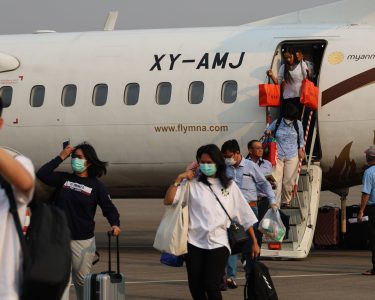Myanmar Investment Review
In this edition of Leader Talks we speak with Nishant Choudhary, Partner, Myanmar Managing Director, and Head of Regional Dispute Resolution Practice at DFDL. With nearly two decades of experience and a frontline role in advising businesses through Myanmar’s complex and evolving legal environment, Choudhary offers expert insights into managing cross-border financial compliance, distressed M&A opportunities, and the sectors poised for future investment.
This in-depth conversation highlights how DFDL continues to guide clients through Myanmar’s legal, regulatory, and operational challenges across both turbulent and transformative times.
MIR: DFDL has been active in Myanmar through many cycles of change. Can you share how the firm first established its presence here, and what personally brought you to work in the country during such a complex period?
DFDL’s presence in Myanmar dates back to 1995, well before the country’s more visible economic opening in 2011. We saw early on that Myanmar had the potential to be a key part of the ASEAN economic landscape, and we were one of the first international law firms to establish a genuine on-the-ground presence here. Our early work involved helping clients navigate a complex legal environment undergoing rapid transformation, from reforms in investment laws to the liberalisation of key sectors.
Read More: Karzo Urges Business-Led Solutions as Myanmar’s Earthquake Exposes Deep Logistics Gaps
What personally brought me to Myanmar was a mix of professional challenge and a belief in the country’s long-term potential. I arrived during a time of both optimism and uncertainty—when the country was rapidly reforming, yet still fragile. The opportunity to help build something meaningful in such a dynamic environment while contributing to responsible legal development was incredibly compelling. It’s been a challenging but enriching experience, helping me grow professionally and make a real difference.
Over the years, our commitment to Myanmar has remained steady, whether stable or volatile, throughout every cycle. Our aim has always been to provide grounded, practical legal advice that helps our clients navigate the legal landscape and the broader realities of doing business in Myanmar.
MIR: Given the FATF greylisting and tightening banking restrictions, how are your foreign clients managing cross-border payments, access to financing, and general financial compliance in Myanmar right now?
Cross-border payments:
Due to FATF greylisting and tightening Central Bank of Myanmar (“CBM“) regulations to address FATF concerns and manage the economic slowdown globally and at home, cross-border payments in Myanmar have become more complex. Foreign clients respond by strictly complying with the Foreign Exchange Management Law and associated CBM regulations. We advise our clients to use the provided channels for remittance approvals; though slow, we have seen them being granted.
All outbound foreign currency remittances require approval from the CBM and the Foreign Exchange Supervisory Committee (“FESC“), an ad hoc body established to manage the Myanmar Government’s fiscal concerns. Foreign currency income must be deposited into Authorised Dealer (“AD“) banks and converted to MMK at:
- Weighted average rate (dynamic rates reflective of the market buy/sell conditions): provides a more accurate benchmark for foreign exchange transactions in Myanmar.
- The official rate (currently MMK 2,100/USD): within one working day for all other purposes.
It is important to understand the difference (and interplay) between the two rates – the reference exchange rate (“RER“) is set by CBM based on prevailing market conditions, international exchange rates and domestic monetary policy objectives. This rate is only used as a benchmark and not the rate at which banks and foreign exchange dealers necessarily need to trade. On the other hand, the weighted average exchange rate (“WAR“) is calculated based on the buying and selling of foreign currency via the online trading platform. The CBM, until recently, set the WAR, but it does not do so anymore. It has permitted market participants to set said rate and has designated it as the market exchange rate. WAR is mandated for use under certain conditions, notably for converting export proceeds, online transactions, and interbank trades.
It must be noted that the compulsory conversion requirement does not apply to the following entities:
- Investments with foreign direct investment, approved by the Myanmar Investment Commission (“MIC“) and the Special Economic Zone Management Committee;
- Foreign companies, i.e., companies with foreign shareholding exceeding 35% of their paid-up capital, may use the funds internally or sell them to the banks;
- International airlines and freight forwarding companies;
- Union Ministries;
- Diplomatic personnel and their families from countries with formal relations with Myanmar, staff of the United Nations and its agencies,
- Myanmar nationals holding UN laissez-passer passports,
- Foreign staff of development agencies, and diplomatic staff of international organisations; and
- International Organisations and Non-Governmental Organisations (INGOs).
(collectively, the “Exempt Entities“)
Advance import payments via telegraphic transfer (“TT“) are restricted and allowed only upon CBM approval.
Clients increasingly use border trade frameworks and alternative currencies to streamline trade and reduce dependence on the USD. Thai Baht (“THB“) has been permitted for use in Thailand-Myanmar border trade since August 2023, with formal CBM guidelines introduced in November 2023. In January 2024, CBM approved Indian Rupee (“INR“) trade settlement through Special Rupee Vostro Accounts (“SRVAs“). Banks such as Punjab National Bank (India), UAB Bank and CB Bank (Myanmar) now support INR trades.
For China–Myanmar trade, settlement in Chinese Yuan is permitted. Under CBM rules, importers may settle trades in foreign currency without prior CBM approval, while exporters can retain export earnings for up to one month before conversion.
On 2 May 2024, the Department of Trade (under the Ministry of Commerce) introduced a Barter Transaction Arrangement (“BTA“) allowing the exchange of goods of equal value between countries without using foreign currency. The monthly trade cap is USD 60 million (USD 30 million each for exports and imports). Eligible companies must be registered under the Myanmar Companies Law, recognised by both governments, and have valid importer/exporter certificates. The 25% export earnings conversion requirement is exempted during the initial test period. A coordination group has been formed to oversee BTA implementation with China. However, the implementation of this arrangement has not been made public.
Access to Financing
CBM’s mandatory foreign Currency conversion requirements for companies that are not Exempt Entities (reduced from 65% in early 2023 to 25% in August 2024) facilitate the availability of foreign currency in the market; however, the demand can not be met alone with such conversions. Outbound remittances for loans, dividends, and capital returns remain subject to FESC approval.
Locally registered foreign businesses can obtain MMK-denominated loans from Myanmar banks, though collateral requirements apply and approval times are slow. Regional affiliates in Singapore or Thailand often structure intercompany equity and loan contributions for Myanmar operations.
Since 2023, border trade financing using THB and INR settlement mechanisms has emerged as a viable alternative. SRVAs offer access to INR-based credit lines supported by CB Bank and UAB in Myanmar.
Inward loans from offshore parent companies are still used but require prior approval by CBM. Smaller operations rely on licensed remittance businesses or group company transfers.
General Financial Compliance
Our clients who are not Exempt Entities adhere to the 25% mandatory conversion rule, FESC approval requirements for outbound payments, and deadlines for collecting export proceeds (30 days for Asian exports, 60 days for non-Asian exports).
Due to FATF scrutiny, clients are enhancing AML/CFT systems, including customer due diligence (CDD), transaction monitoring, sanctions screening, and reporting.
They ensure compliance with local tax and accounting obligations—corporate tax filings, withholding tax, and audited financials. All cross-border payments are processed through licensed AD banks and are supported by documentation (invoices, declarations, tax clearances, board approvals).
Clients avoid informal channels (e.g., hundi), which are prohibited and subject to penalties. They also monitor:
- CBM policy updates on foreign exchange rules and digital payments;
- FATF and APG compliance status; and
- Sector-specific compliance requirements for SEZs and MIC permit holders for general and border trade businesses.
MIR: The recent earthquake exposed severe infrastructure vulnerabilities and highlighted broader operational risks. What legal or contractual protections are businesses now seeking to safeguard supply chains and logistics in Myanmar?
Force Majeure Clauses
Businesses are seeking more precise force majeure clauses in contracts. These now explicitly reference earthquakes, related natural disasters, infrastructure collapse, and logistics disruptions. General “acts of God” language is increasingly considered inadequate by parties. The clause is often tailored to address the recent political crisis and the natural calamity.
Contractual Flexibility
We are also seeing increasingly carve-outs for parties to a contract to secure the liberty to opt for different supplies and vendors based on trigger points. This enables the parties to be more flexible during disruptions of business/supply chains.
Contracts are incorporating provisions that allow renegotiation in response to major disruptions. Force majeure definitions now include infrastructure collapse and government-mandated transport suspensions. UNCITRAL Article 79 principles are invoked to support temporary performance suspension and good-faith renegotiation.
Supply Chain Diversification
To mitigate infrastructure risks, companies are diversifying suppliers and logistics routes. Infrastructure collapse has led to freight being rerouted via alternative transit corridors.
Insurance Coverage
Earthquake insurance coverage is available under private fire and allied perils insurance. Following the March 2025 earthquake, some insurers temporarily halted disaster coverage, exposing significant gaps. Companies now consider parametric or business interruption insurance that pays out promptly upon measurable seismic activity.
Legal Compliance
To mitigate regulatory risk, businesses are ensuring compliance with disaster management laws and infrastructure safety regulations.
MIR: With many local businesses under pressure, some foreign investors are eyeing distressed M&A opportunities. From your experience, what should buyers look out for regarding legal red flags and hidden upside?
Distressed M&A transactions in Myanmar are creating opportunities for well-prepared investors. While legal and regulatory complexities reflect the ground realities and sector-specific investment restrictions that investors have to navigate, workable solutions are also available. Thus, you would see that strategic investors are now placing themselves and winning on the discount due to local distress. Per my understanding, these investors tend to see a more fruitful outcome on the economy’s upside, especially given the current discount available in the market. Some of the typical ways for foreign investors to navigate these complexities can be summed up as follows:
- Due Diligence
Investors intending to operate in Myanmar must undertake enhanced due diligence on ownership structures, counterparties, and supply chains to mitigate the risk of sanctions breaches and reputational harm. Given Myanmar’s current status with the Financial Action Task Force (FATF), compliance with international sanctions frameworks remains critical. Myanmar’s foreign investment regimes (MIC and SEZ) impose sector-specific/general requirements. While investment in most sectors is largely open for foreign investors, limited sectors require mandatory minority local partnerships and prior approval from the MIC and SEZ before sale, as the case may be.
If the investors seek to purchase any business through the enforcement mechanism via the lenders, share pledges and security enforcement mechanisms may face procedural and practical challenges under Myanmar law, particularly in insolvency. Accordingly, investors must carefully factor enforcement risk (primarily delays and procedural hoops) into deal structuring, per our previous experiences, especially where we are seeing a market discount ranging from 30% to 60% above, strategic investors tend to take along the sponsors of the businesses they are trying to acquire through lenders’ enforcement process. This is also beneficial in avoiding potential contentious situations in the future and allows taking all necessary undertakings from the outgoing sponsors.
- Acquisition financing aspects
There are general concerns regarding Myanmar, and this financial support from banks is not what it used to be prior to 2021. Thus, the level of Myanmar exposure that investors’ financiers are willing to take in Myanmar would have to be ascertained in advance. Currently, Myanmar banks (including foreign licensed banks) are conservative regarding Myanmar. Thus, local financing sources would likely not be available unless there is a certain degree of relationship at the parent level, which brings the lender’s confidence, whether based on contractual comforts or otherwise. Notwithstanding the above, Myanmar is also a decently sized local market with a population of around 54 million; thus, there will always be demand for the right investments locally.
- Flexibility to Structure the Acquisition
Save for the telecom sector, the absence of a formal takeover code gives buyers flexibility to negotiate deals with tailored terms, including exclusivity, phased investments, and customised governance. Additionally, Myanmar’s sectors, such as power, infrastructure, and manufacturing, continue to offer strong long-term growth potential, especially as regulatory clarity improves.
- Regulators Recognising Market Shift
It is important to note that regulators are increasingly recognising the potential of distressed asset acquisitions as a critical tool for supporting corporate recovery and, by extension, economic stability. With guidance from legal advisers such as our firm, regulators are gaining a deeper understanding of the complexities involved in these transactions and are well placed to facilitate timely approvals aligned with project timelines.
MIR: Despite the challenges, Myanmar remains of long-term interest to many strategic investors. Are there any legal reforms or market shifts that signal potential turning points—or at least areas where forward-looking businesses should start paying attention?
Despite the ongoing political and economic challenges, Myanmar continues to attract long-term interest from strategic investors across various sectors. This sustained interest is rooted in the country’s substantial market potential, abundant natural resources, and strategic Southeast Asian location. It is important to understand the legislative landscape since 2018, which has shaped investor sentiment substantially. Below, we have provided a brief outline to showcase the legal reforms over the years and the market shift in the wake of the pandemic and the political events of February 2021.
Pre-2020
Below are some recent legal enactments that flipped investor sentiment positively until the political crisis. These reforms are still in place and available to the investors.
- Investment Legal Regime
Since 2017, Myanmar has been undertaking substantial legal reforms to create a more investment-friendly environment. The enactment of the Myanmar Investment Law 2016 (MIL) and the Myanmar Investment Rules 2017 has been central to this effort.
These legislations consolidate and modernise the country’s investment regime by streamlining procedures, clarifying regulatory authority, and offering incentives such as income tax holidays, exemptions on customs duties, and long-term land use rights. Investors benefit from clearer dispute resolution mechanisms and guaranteed protections against expropriation. The reforms brought Myanmar’s legal framework in line with international norms and aimed to position the country as a viable long-term destination for foreign direct investment.
- Myanmar Corporate Legal Regime
The Myanmar Companies Law 2017 (MCL) was enacted on 6 December 2017 and came into effect on 1 August 2018, replacing the outdated Myanmar Companies Act 1914. It introduced a modern legal framework for company incorporation, management, and governance, and was a key part of the government’s broader effort to attract foreign investment and align domestic laws with international standards.
One of the most significant reforms under the MCL was the redefinition of a “foreign company.” Foreign investors were permitted to hold up to 35% of the shares in a local company without triggering a change in its status to a foreign company. This reform opened up new opportunities for foreign investment in previously restricted sectors, including public companies listed on the Yangon Stock Exchange.
The MCL also simplified incorporation requirements by allowing companies to be established with a single shareholder and a single director, provided at least one director was ordinarily resident in Myanmar. It abolished the need for a “Permit to Trade,” reducing administrative barriers for foreign entrants.
Additionally, the MCL replaced the traditional memorandum and articles of association with a single constitution and granted companies full legal capacity to undertake any lawful business activity. These changes enhanced operational flexibility and helped modernise Myanmar’s corporate landscape. It also established an online portal that supports all processes relating to a company, from incorporation to compliance and winding-up, without having to undertake any physical process.
- Insolvency Legal Regime
Myanmar’s enactment of the Insolvency Law 2020 marks a major step forward in aligning its legal framework with international standards. Replacing century-old colonial legislation, the new law introduces a modern regime for corporate insolvency and restructuring, with clear liquidation, rehabilitation, and cross-border insolvency processes. It reflects global best practices, including elements of the UNCITRAL Model Law, and is designed to provide clarity and certainty to creditors and investors alike.
A key feature of the law is the introduction of corporate rescue and rehabilitation mechanisms and a sine qua non that allow distressed companies to restructure and continue operating, rather than face immediate liquidation. This approach helps preserve value for creditors, protect jobs, and ensure business continuity, which are essential considerations for foreign investors operating in emerging markets.
The law also includes tailored provisions for micro, small, and medium enterprises (MSMEs), recognising their central role in Myanmar’s economy. By making insolvency proceedings more accessible and efficient for smaller businesses, the law aims to enhance overall economic resilience.
Overall, the Insolvency Law 2020 can be seen as paving the way for improving investor confidence by strengthening legal predictability and commercial risk management in Myanmar.
Post 2020 – the market shift and EMERGING LEGAL TRENDS
- Liquidity Issues and Mitigations
In response to the economic strain caused by the COVID-19 pandemic and the political instability following the 2021 military takeover, the CBM issued a series of urgent regulatory measures to stabilise the financial system, preserve liquidity, and promote digital transactions. The measures were geared towards maintaining financial discipline and accelerating Myanmar’s transition towards a more formal and digital economy.
Liquidity and Reserve Requirements:
The CBM repeatedly adjusted the liquidity ratio calculation between 2020 and 2022, increasing the weight of treasury bonds up to 100% to improve banks’ liquidity positions. Simultaneously, the minimum reserve requirement for banks was gradually reduced from 10% to 3% to ease cash flow pressures. These measures were aimed at maintaining financial stability during periods of uncertainty.
Digital and Cash Payment Controls:
CBM capped cash payments at MMK 20 million per transaction and mandated digital payment methods for amounts above this threshold to promote cashless transactions and manage currency in circulation. Banks were directed to prioritise digital transfers over cash disbursement, particularly in payroll, pensions, and government projects. Limits were also placed on merchant cash withdrawals from digital sales, and specific protocols were established for reporting and verifying such transactions.
Foreign Exchange and Export Earnings:
The CBM mandated that all residents’ foreign currency income be converted to kyat within one business day, except for Exempted Entities. Thus, all foreign investors fall under the Exempt Entities category and can keep their forex earnings. Exporters were required to convert or use export earnings within 30 days. New currencies such as the Chinese yuan and Japanese yen were added to the list of tradable currencies, and direct kyat-settlements were allowed for India, China and Thailand border trades to facilitate cross-border transactions.
Cash Availability and Withdrawal Limits:
To control physical cash flow, strict withdrawal caps were introduced for individuals and businesses. These included daily and weekly limits across ATMs, mobile wallets, and OTC counters, except for health, religious, and COVID-related expenses. The measures were aimed at curbing speculative withdrawals and ensuring controlled cash circulation.
These reforms demonstrated the government’s intent to “hunker down” and safeguard monetary stability in the face of the economic and political crises, as well as promote the digital economy.
- Prioritisation of Investment Sectors:
In November 2021, the Myanmar Investment Commission (MIC) issued a list of investment sectors receiving priority attention to encourage national development and state building. These sectors included manufacturing (e.g., fertilisers, cement, iron and steel), value-added food processing, electric vehicles (more on this below), pharmaceuticals, medical devices, agriculture, livestock, and public transportation services. The focus aimed to attract local and foreign investors to vital national growth areas.
- Implementation of Intellectual Property Laws:
Myanmar has implemented the new intellectual property laws to align with international standards. The Copyright Law, passed in 2019, came into effect on 31 October 2023, enhancing protections for creators and investors in creative industries.
- Electric Vehicle Sector Development
Recently, Myanmar has been actively promoting its electric vehicle (EV) sector through tax incentives, investment promotion, and infrastructure development. Under the Union Tax Law 2023, battery electric vehicles (BEVs), their parts, and batteries are exempt from special goods tax, commercial tax, and customs duties, making imports more cost-effective.
In February 2023, the MIC designated EV-related activities (including vehicle manufacturing, component production, battery assembly, and charging infrastructure development) as promoted sectors. Investors in these areas are eligible for tax exemptions and incentives under the Myanmar Investment Law 2016. The government has established a dedicated steering committee to support the sector’s long-term growth and is planning local EV production using the semi-knockdown (SKD) system by 2026. This initiative is expected to reduce costs, generate employment, and enhance domestic capabilities.
In summary, I think businesses should look into the following sectors in the near future:
- Digital Infrastructure & Payments: With regulatory support for digitisation and cash controls in place, fintech, e-commerce, and mobile payment platforms are potentially primed for growth.
- Electric Vehicles & Clean Tech: MIC incentives and tax breaks position the EV sector as a future-facing opportunity, particularly for component manufacturing, battery tech, and charging infrastructure.
- Healthcare & Pharma: As a promoted sector, pharmaceutical and medical device investments will benefit from incentives and are vital for Myanmar’s development needs.
- Distressed & Turnaround Opportunities: The new Insolvency Law creates space for structured distressed asset acquisitions and restructuring deals, especially for foreign investors with turnaround expertise.
- Creative and IP-Driven Industries: With the IP framework coming into force, businesses in media, tech, and content can now better protect their assets.
For more information click here to request a conversation with DFDL.





